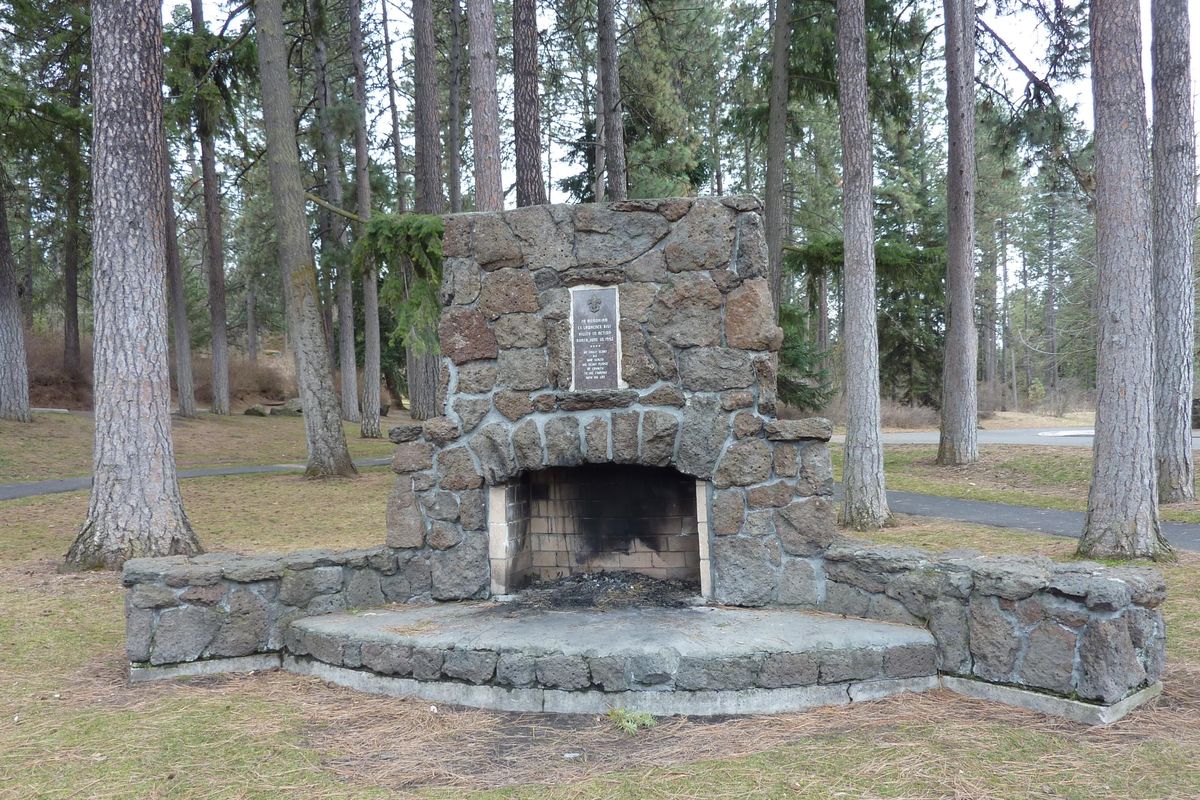Landmarks: The man behind the Manito Park firepit

People enjoying Manito Park in cold weather months or on cool summer evenings have for many decades warmed themselves – or toasted marshmallows – at the large wood-burning hearth located just beyond the southwest corner of the mirror pond near 19th Avenue and Browne Street.
That hearth, the Lawrence Rist Memorial Fireplace, has a compelling story behind it, as is the case with many sites and monuments created in memory of someone from years ago.
Albert Lawrence Rist was born in 1926, the son of Marian and Marion Rist, and grew up in Spokane. He had a sister named Marilyn and graduated from Lewis and Clark High School in 1944. On June 10, 1952, as a second lieutenant in the United States Army’s 180th infantry regiment of the 45th infantry division, he was killed in combat in the Korean War.
He was also survived by his wife Lavar and 15-month-old daughter Andrea, who resided at their home on North Belt Street. His body was returned to Spokane and he was buried at Spokane’s Riverside Memorial Park on Aug. 2, 1952.
As a boy he was involved with the Boy Scouts, earning Eagle Scout rank in September 1941. He enlisted in the U.S. Navy in 1945 in the waning days of World War II, serving as a quartermaster and assigned to an LSM (landing ship medium, an amphibious assault ship) in the Pacific Theater of operations; he was discharged from military service in January 1946.
He enrolled at Washington State College in Pullman, where he was a member of Kappa Sigma fraternity and Alpha Phi Omega National Service Honorary, he earned a Bachelor of Science in general studies in 1950.
Rist remained active with scouting and was scoutmaster of Boy Scout Troop 4 at Roosevelt Elementary School at the time of his recall to active military service for the Korean War, according to a newspaper story in 1953.
No records could be found at the Inland Northwest Council of the Boy Scouts of America providing information about just when and how Troop 4 started the project to create a free standing memorial fireplace for their former scoutmaster, who was known by his middle name, Lawrence; however, the council did verify Rist’s near-lifetime affiliation with the Scouts. One newspaper account noted that the Troop 4 Scout mothers were accepting donations to fund the project and that material was being donated by individuals and businesses.
The hearth made of mortared basalt on a poured-concrete foundation was designed by Funk, Molander & Johnson architects and features a semicircular front with a smooth concrete top layer, a firebox made of brick, over which is a segmental arch of vertically laid stones and a basalt enclosed chimney. Stone ledges flank the central portion of the structure.
A memorial plaque made of bleu beige marble that was quarried in Belgium is in place above the firebox and includes the Boy Scout insignia which is “the original casting from which all Boy Scout flag pole emblems have been made,” according to one newspaper article.
Part of the plaque reads: “An Eagle Scout … who sealed his Scout pledge of loyalty to his country with his life.”
Much of the work on the big open fireplace was done by members of a construction crew that Rist had once worked with and by members of his Kappa Sigma fraternity brothers.
A newspaper article notes that 181 large redwood rounds – weighing an average of 60 pounds each – were laid in front of the fireplace to serve as a level “paved” area. These circular slabs were shipped from Crescent City, California, and were said to be impervious to rot and insects. They are no longer in evidence, and it isn’t known if they were removed or if grass grew over them in the intervening years. Park manager Steve Nittelo said that while he couldn’t be certain, it’s possible the rounds had been put in place so that skaters on the pond could walk to the fireplace in their skates and not have to walk over pebbles.
The memorial fireplace was dedicated on Aug. 30, 1953, with members of Troop 4 on hand as well as Boy Scout officials and others involved with the inception and construction. The project has a completion date listed as 1955.
There are three other interesting things to note about the Lawrence Rist Memorial Fireplace. First, the structure is one of the contributing elements in Manito Park that helped garner for the park designation on the National Register of Historic Places in 2015.
Spokane resident Sharon Leon often walks her dog in the park and was drawn to the basalt cook-out memorial a few years ago. As she has done for other individuals who do not have such recognition, she was moved to create a memorial for Rist at findagrave.com, a national online catalog of cemetery records.
And finally, Lawrence Rist’s parents lie buried right next to their son at Riverside Memorial Park. They both lived into their 90s. Their son gave his life for his country in war. He was just 25.